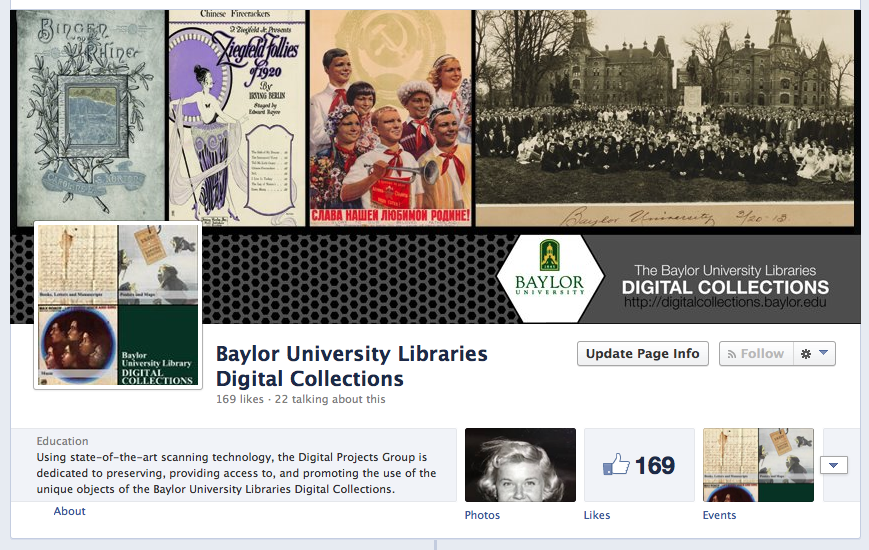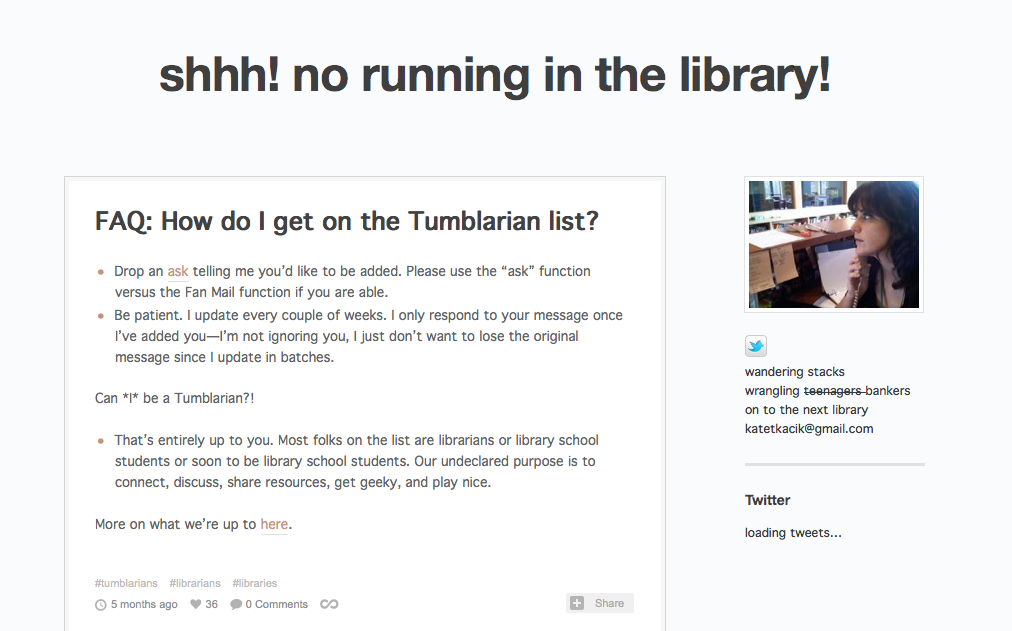
It’s become an accepted fact – and has drifted well into trope territory – that everyone is obsessed with social media. Saturated with it. Filtered through it. Even addicted to the point of being unable to sit through an entire meal without checking it. The corollary to this “fact” is that everyone, everywhere should be using every conceivable format to deliver the minutiae of their lives via as many pixel-dependent, wirelessly-delivered vehicles as possible.
I know this to be true because I just used my smart phone to Google quotes about social media that people Tweeted to their followers before reblogging it on their Tumblr accounts, all while Instagramming my morning snack as I listened to Spotify.
Increasingly, we are asked by users, colleagues and random people on the street what kind of social media we’re using, and, more importantly, why? So I thought it might be illuminating to outline what social media/outreach avenues we do use, and address the reasons why we don’t use others.
Blog (hosted by EduBlogs using WordPress)
If you’re reading this post, then you already know we have a blog. But you may be a new reader, or someone who’s always wondered, “Why a blog, exactly?” Simple: a blog allows for longer investigations, deeper reporting and an agile approach to providing context and access for our digital collections. Here on the blog, I can wax poetic about a single item, opine on the state of the industry, or just take a moment to tell you about our latest collections. It’s a multipurpose platform that’s gotten us a fair amount of contact from the general public and from researchers looking into a specific topic.
The blog is great for all of this, but it isn’t our first choice for a “catch-all” execution that would serve as a hub for our social media strategy. That distinction goes to …

Facebook (www.facebook.com/baylordigitalcollections)
By now, we’ve all heard the conventional wisdom about Facebook: everybody has one, but at first it was only college students, and then the teenagers came in, and now it’s all people “your mom’s” age, and wow, isn’t that funny? I’m reminded of the old Yogi Berra joke: “Nobody goes there, it’s too crowded.”
The truth is, of course, that Facebook has an enormous global reach, and it serves a wide range of people from high school students through retirees, businesses to non-profits. We use Facebook as an aggregator of our various social media executions: we’ll post links to the blog, a photo of an item from the collections, a link to a colleague’s blog post, anything that might be of interest our 169-and-counting friends. A big advantage for us is the residual exposure we get when a friend shares something on our page, which is seen by their friends, and their friends’ friends, and on and on until every person on the planet has seen it. (This only happens in cases of cat-related memes or recipes for Jalapeno Ranch Dip – JUST LIKE CHUY’s!!!!#!%!$%.)

Flickr (www.flickr.com/baylordigitalcollections)
Flickr is a pretty straightforward platform that allows users to share photos, either to their friends and family or to the world. It’s been used by large institutions for years to add materials to The Commons, a project that seeks to catalog and describe photos from collections at places like the New York Public Library, the Texas State Archive, the National Archives and more.
We use Flickr to post small sets of images from our collections that we’d like users to find and use in their own creative executions, or to show what an item might look like if it were digitally restored (as opposed to the non-retouched versions that live in our Digital Collections). By far the most-accessed set of images to date is our set of full-plate images from the War of the Rebellion Atlas.

Twitter (@GWTruettSermons)
It’s personal confession time: Twitter doesn’t much appeal to me. I mean, I get the instant access to breaking news, and the ability to follow lots of sources for information, but the ability to blurt the latest random thought or retweet someone else’s random thought just doesn’t do much for me. Fortunately, it also isn’t an avenue that lends itself to our strengths as a group, except in the case of the George W. Truett Sermons collection. For that, we did create a Twitter account to deliver twice-weekly snippets of Rev. Truett’s sermons to our small (but growing) base of followers. But until we become a “breaking news” kind of shop, we’ll probably not be launching an official DPG Twitter account any time soon.

Tumblr (baylordigitalcollections.tumblr.com)
If you’ve made it this far, you deserve to be rewarded, so here you go: We’ve just launched a new Tumblr blog! You can find it at baylordigitalcollections.tumblr.com, and we’ve chosen to call it Digitized and Randomized. Our vision is to make it a daily source of completely randomized materials from the collection, including photos, quotes, video clips and more.
Tumblr is a “micro-blogging” site that allows users to post bite-sized snippets of information. It bills itself as platform that allows you to “effortlessly share anything,” with a philosophy that focuses on creativity, positivity and geekiness. It’s also loaded with memes. Lots and lots of memes.
Tumblr also tends to skew younger, though it does have an active core of library professionals (dubbed Tumblarians, natch) who post library and archive-related materials, literary trivia and general library nerd-fuel. We are actively hoping to be included on one of the influential lists, like this one.

Now, I know what you’re saying: “But Mr. Curator Guy, I don’t want to fire up another account just to see this awesome new outreach tool. Can I follow your Tumblr without signing up for one myself?” Well, Mom, the answer is, “Yes!” Just bookmark the URL as a favorite, or us your RSS reader to follow our feed and you’ll never miss a post. But I’d encourage you to sign up for an account anyway, especially if you like things that are funny. Or related to “My Little Pony: Friendship Is Magic.” Or GIFs.
The Eternal Question: Why Aren’t You On Pinterest?
Another personal confession: my wife has recently become a Pin-Friend. (Or a Pinner. Or a Pinfluential Person, or whatever people who spend increasing amounts of their free time browsing the limitless time-devourer that is Pinterest.) We get asked now and again why we’re not using Pinterest for our digital collections, and the answer is two-fold.
One, it doesn’t play particularly nicely with CONTENTdm, the software that presents our collections online. Not to get too far into technical details, but Pinterest needs a stable source for its image files (i.e., something that ends with .jpg in a URL) to work nicely. That way, people can find it, “pin” it and access it later when they want to see it in its original context. CONTENTdm serves up content as a series of dynamic files that includes image files like Pinterest needs, but it’s not obvious to most people where to find them, and anything that makes using our collections more confusing is not something we’re interested in pursing at this time.
Secondly, we don’t have much in the way of restaurant copycat recipes, cat photos or decorations for themed birthday parties, so it doesn’t really fit with our core content at this time. But who knows? Maybe someday someone will donate the world’s largest collection of Princess Fantasy Birthday Party Idea photos, and Pinterest will make more sense for us.
(You should, however, check out the official Baylor Proud Pinterest page – it’s awesome!)
***
We hope you’ll find time to check out all of our social media channels, and engage with us where you feel the most connection. And if you have ideas for how we can make them better, drop us a line at digitalcollectionsinfo@baylor.edu. For our Tumblr followers, that’s an email address, and it’s something people used to communicate in the mid-1990s. (Ask your grandparents.)